Connect with Us
602 Park Point Drive, Suite 225, Golden, CO 80401 – +1 303.495.2073
© 2025 Medical Affairs Professional Society (MAPS). All Rights Reserved Worldwide.
As with so many aspects of Medical Affairs, a successful insights management process requires a strategy-first approach; one example is defining listening priorities based on company and Medical strategic imperatives prior to initiation of insights gathering. The idea that insights management requires strategy before implementation may seem obvious (and, indeed, is a central point of the previous MAPS/Within3 white paper on this subject), but the specifics of how to clearly articulate and effectively implement the insights strategy remain a major challenge area for Medical Affairs teams, including the following:
Insights management may seem reactive in that it monitors the external scientific, clinical, healthcare, governmental, societal and patient landscapes for new knowledge/opinions/trends that allow an organization to react/respond accordingly. However, choosing what to listen for and designing the mechanics of data generation and analysis must be proactive to ensure it is strategically anchored. In fact, best-in-class insights management teams have a dual approach, first defining strategic listening priorities and secondly putting systems in place to answer the question, “Is there anything we’re missing?” This can be seen as listening both narrowly (for priorities) and broadly (for emergent learnings). Different people/processes/technologies may be more useful for these two different types of listening, for example using targeted strategies of Medical Science Liaison (MSL) engagements and advisory boards to monitor listening priorities, alongside a broader social listening strategy to identify unexpected landscape trends.

 Insights have become an expected deliverable and sometimes used as metric for Medical Affairs teams. This presents the danger of collecting insights only as a checkbox exercise. This is often the result of teams focusing on the activities they will use to gather insights and not on the strategic purpose of insights. This can result in executing many tasks for insights gathering but with little to no impact. Impulsive insights gathering can also stem from reacting to perceived “fires,” e.g., scheduling an advisory board to learn more about a recently surfaced trend, which in hindsight may not be the actual fire it initially seemed. These challenges can be mitigated by establishing a yearly insights planning cycle, leaving room for some spontaneous activities that respond to time-sensitive threats or opportunities, whilst remaining focused on listening for strategic priorities driven by overarching product and therapeutic area strategy.
Insights have become an expected deliverable and sometimes used as metric for Medical Affairs teams. This presents the danger of collecting insights only as a checkbox exercise. This is often the result of teams focusing on the activities they will use to gather insights and not on the strategic purpose of insights. This can result in executing many tasks for insights gathering but with little to no impact. Impulsive insights gathering can also stem from reacting to perceived “fires,” e.g., scheduling an advisory board to learn more about a recently surfaced trend, which in hindsight may not be the actual fire it initially seemed. These challenges can be mitigated by establishing a yearly insights planning cycle, leaving room for some spontaneous activities that respond to time-sensitive threats or opportunities, whilst remaining focused on listening for strategic priorities driven by overarching product and therapeutic area strategy.
Medical Affairs teams see insights as an opportunity to drive company strategy and help cement the function’s place alongside R&D and Commercial as a third strategic pillar in the biopharmaceutical and MedTech industries. Senior leadership, however, may require demonstration of insights value before they share this opinion. Allocating resources to insights generation may be especially challenging in small and/or precommercial companies, in which the appreciation of the potential impact of insights on R&D and Clinical Development lags behind the understanding of insights as drivers of HCP behavior. No matter the size of the organization, resourcing remains an ongoing challenge for many Insights teams. In generating organizational buy-in for insights infrastructure it is useful to look beyond the impact of insights on Medical Affairs strategic priorities to demonstrate how insights will benefit company-wide priorities.
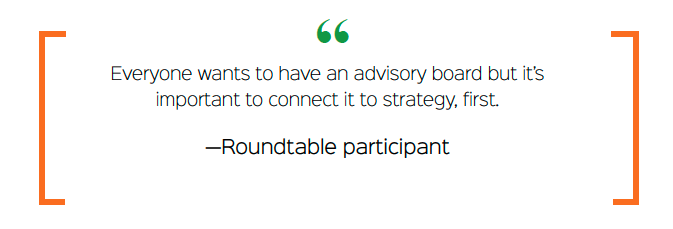
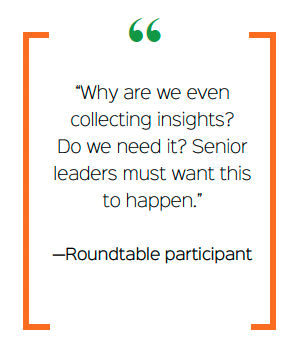
Medical Affairs is not the only function that generates insights. Commercial, competitive intelligence, investor relations and to some extent R&D also collect, analyze and report insights. It may be difficult to make the case for Medical “ownership” of insights, especially when Commercial insights are likely to be supported and/or justified by metrics measuring Return on Investment (ROI). That said, Medical Affairs has access to the most diverse sources of evidence based insights (KOLs, HCPs, RWE, patients/caregivers etc.) and also the clinical/scientific understanding to contextualize the impact of insights on driving strategy. For these reasons, many organizations are exploring insights structures in which Medical Affairs can serve as the unifying partner, gathering insights and then communicating relevant data and insights to cross-functional colleagues internally.
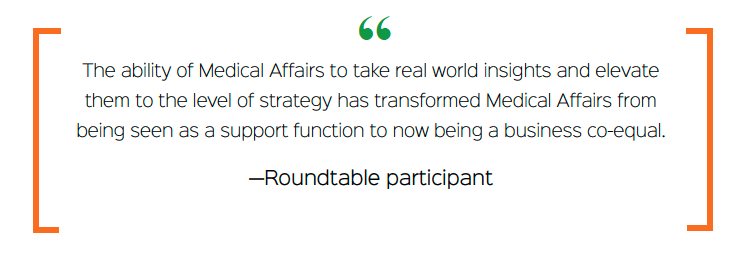
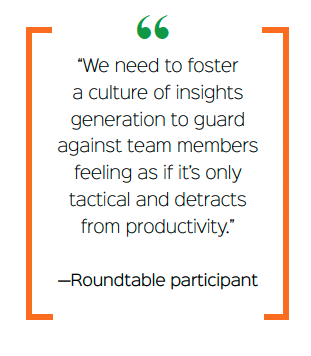 Just as it may require tact and persistence to ensure C-suite buy-in for insights activities, it may require work on the part of Medical Affairs leaders to ensure team members on the ground and in the field appreciate the need to prioritize insights activities. One roundtable participant described an organizational structure in which global medical directors were tasked with analyzing and reporting insights – but insights hadn’t yet been added to their annual key objectives. Likewise, many participants report feedback from MSLs that insights gathering were seen as a distraction from their “real” job of communicating the company’s scientific and clinical data in support of the scientific narrative. Successful Medical Affairs departments ensure that insights gathering and analysis are placed alongside other strategies as key Medical objectives and that team members are given remit and held accountable for their roles in insights management.
Just as it may require tact and persistence to ensure C-suite buy-in for insights activities, it may require work on the part of Medical Affairs leaders to ensure team members on the ground and in the field appreciate the need to prioritize insights activities. One roundtable participant described an organizational structure in which global medical directors were tasked with analyzing and reporting insights – but insights hadn’t yet been added to their annual key objectives. Likewise, many participants report feedback from MSLs that insights gathering were seen as a distraction from their “real” job of communicating the company’s scientific and clinical data in support of the scientific narrative. Successful Medical Affairs departments ensure that insights gathering and analysis are placed alongside other strategies as key Medical objectives and that team members are given remit and held accountable for their roles in insights management.
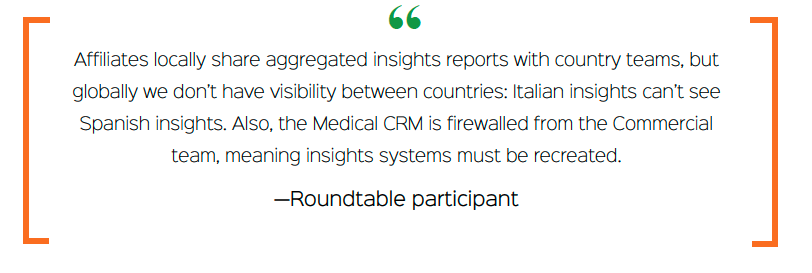
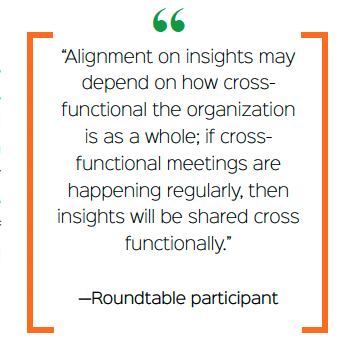 Many companies build insights systems in silos such that insights are reported upward to leadership but are not also disseminated throughoutthe organization laterally or downwards. These siloed insights systems may have been adequate when insights were only used tactically and thus only had relevance to specific subfunctions; however, now with the potential for insights to influence company-wide strategy, alignment on insights across the business is essential. Unfortunately, businesses that have implemented siloed insights systems may have significant challenges moving to a more integrated model. Differences in data sources and formatting, along with differences across the processes and technologies used to generate, analyze and communicate insights may make insights silos especially durable, requiring multi-year IT projects to dismantle existing structures and rebuild them into a more integrated framework. Ideally, critical success factors and key insights topics would be defined at the therapeutic area and/or brand level, then translated down to local customer engagement plans to involve MSLs in closing specific knowledge gaps, where they feed back into further strategic planning.
Many companies build insights systems in silos such that insights are reported upward to leadership but are not also disseminated throughoutthe organization laterally or downwards. These siloed insights systems may have been adequate when insights were only used tactically and thus only had relevance to specific subfunctions; however, now with the potential for insights to influence company-wide strategy, alignment on insights across the business is essential. Unfortunately, businesses that have implemented siloed insights systems may have significant challenges moving to a more integrated model. Differences in data sources and formatting, along with differences across the processes and technologies used to generate, analyze and communicate insights may make insights silos especially durable, requiring multi-year IT projects to dismantle existing structures and rebuild them into a more integrated framework. Ideally, critical success factors and key insights topics would be defined at the therapeutic area and/or brand level, then translated down to local customer engagement plans to involve MSLs in closing specific knowledge gaps, where they feed back into further strategic planning.
The challenge is when any of these three – people, process and technology – are not clear or are not coordinated. Who is leading? What are the timelines? What are the expectations and deliverables? How can we ensure we are all capturing insights in the same way? Are we all sharing in the same way? The simpler these processes, the easier it is to follow. Unfortunately (to reiterate this paper’s introduction), only 9% of surveyed individuals felt as if their insights management processes/platforms were streamlined enough to not feel cumbersome.
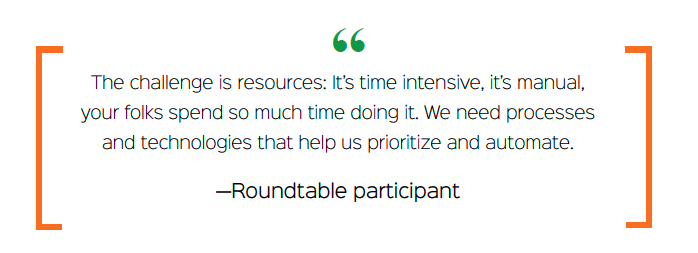
Data fuels insights. In Medical Affairs, data is derived from many sources, some digitized and some generated from person-to-person interactions. Additionally, individual data points may have very different weights, with some immediately warranting elevation to “insights” and others requiring a critical mass of supporting data before coalescing into an insight. Along the way, there are many challenges, including the following:
On one hand, Medical Affairs teams are already challenged to integrate the data from traditional sources such as ad boards, MSL/HCP interactions, congresses, publications, medical information etc. In addition, new technologies offer the opportunity to expand beyond these traditional data sources to involve even more data sources from across the ecosystem (e.g., EMRs and social listening). The thought of homogenizing data from traditional and emerging sources into a standardized format that can be uploaded into the company data lake is enough to make a junior database administrator consider going back to law school. Meanwhile, individuals within the organization are basing their actions on insights – some of which are aggregated, validated and matched with strategic priorities, and some of which are simply observations from their last HCP engagement. An emerging best practice is to collate data from all sources into a centralized data repository including structured and unstructured sources where it can be queried for meaning. Actioning this recommendation requires a strategic approach driven by an integrated insight generation plan.

As companies have added insights management capabilities, the tendency has been to layer the responsibility of insights management and analysis onto teams such as MedInfo, Field Medical, Publications, etc. in addition to their core responsibilities. This approach has two major drawbacks: First, this asks more of teams that are often already stretched thin; second, it makes insights seem like a nice-to-have alongside the must-haves of their core function. Many organizations are addressing this challenge with insights-specific roles or collaboration with third party partners.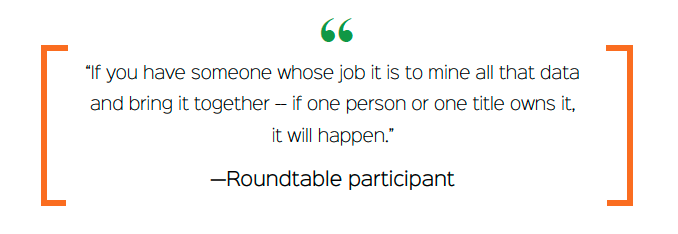
An insight based on last year’s data may no longer be an insight. As such, this challenge could reasonably be listed in any of this paper’s three major sections but is listed here due to round table participants’ consensus that identifying and accessing timely data is the crux of insights efficiency (followed closely by insights analysis). The ultimate goal of insights efficiency is real-time data capture and analysis, though most organizations remain far from this endpoint. Efficiency may benefit from automation using NLP and AI technologies.

The need to adopt new technologies is a challenge but also a major opportunity for Medical Affairs. The challenge stems from the difficulty in sorting the “wheat from the chaff” of so many seemingly promising solutions, and the danger of investing in a solution that proves ineffective or becomes immediately outdated. The opportunity of innovation is to fundamentally transform the insights management process from a laborious, by-hand activity to some degree of automation – not only generating insights, but tracking sentiment, floating strategically important insights to the top, validating between sources and more.
This section encompasses many ideas; however, all address the central question, “Now that we have data, what do we do with it?” The fact is, all the hard work that goes into generating insights data represents not the finish line but the starting line: Only when insights are floated to the top of this data and are communicated in a way that creates actions does the entire insights management process create impact. There are, of course, challenges:
Despite widespread agreement among insights leaders that information must be strategic and actionable to be truly considered an ‘insight,’ many Medical Affairs team members continue to populate insights reports with facts, opinions or anecdotes. The fact is, many people, teams and even departments within Medical Affairs fail to align on the definition of an insight. This leads to insights teams feeding back 100 “insights” that are little more than things they have heard. Operationalizing insights management starts with training team members to recognize an insight and distinguish between information that should be prioritized and elevated, information that might be stored and aggregated, and information that is unlikely to have strategic value. Importantly, distinguishing insights from other forms of information is one of the most difficult steps to automate, highlighting the importance of Medical Affairs’ clinical and scientific expertise. This can be managed by an internal or external dedicated resource.
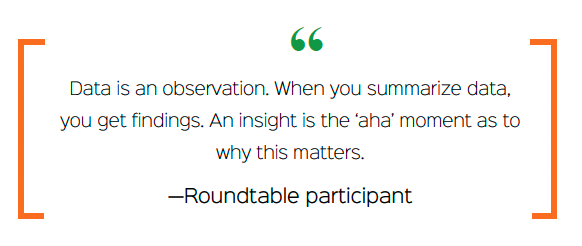
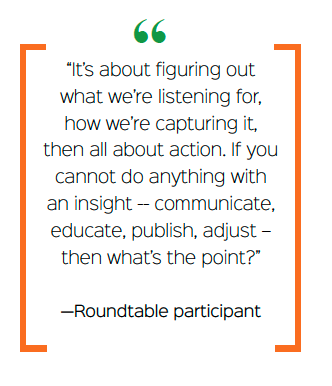 Insights must be shared cross-functionally and with senior leadership to drive strategy for the organization and not just for Medical Affairs. As a corollary, it is important for Medical Affairs to possess the business acumen needed to know which leadership is best positioned to action Medical Affairs insights; for example, insights affecting the early lifecycle might be best actioned by R&D or Clinical Development (where early insights may influence eventual access), while insights relating to a more mature product may best be actioned by Commercial. Matching insights with appropriate cross-functional partners may be best addressed by filtering insights to give access only to certain teams (e.g., clinical trials teams).
Insights must be shared cross-functionally and with senior leadership to drive strategy for the organization and not just for Medical Affairs. As a corollary, it is important for Medical Affairs to possess the business acumen needed to know which leadership is best positioned to action Medical Affairs insights; for example, insights affecting the early lifecycle might be best actioned by R&D or Clinical Development (where early insights may influence eventual access), while insights relating to a more mature product may best be actioned by Commercial. Matching insights with appropriate cross-functional partners may be best addressed by filtering insights to give access only to certain teams (e.g., clinical trials teams).
Previously, Medical Affairs measured the impact of insights using a model of anecdote and experience. Now the function is learning to measure impact using data and analytics. Have we shortened the timeline to access? Have we presented clearer information based on feedback? Are the insights presented in a timely enough manner to remain relevant? Are we using longitudinal measures to demonstrate change over time rather than presenting static reports? Many organizations continue to report challenges in measuring the impact of insights.

We strategize. We generate insights. We analyze and report them. Strategy changes. There is much rejoicing. However, this model lacks an important final step: Communicating this impact back to the individuals and teams responsible for the insight. Successful Medical Affairs departments regularly celebrate the people who contribute to meaningful insights. They also share this success with cross-functional leadership and teams to highlight the impact of Medical Affairs as a whole. Additionally, insights teams may consider sharing the impact of insights with original insight sources, such as reporting back to an ad board or reaching back to thank a KOL for their impactful contributions, letting them know what we did more, better or different as a result of the feedback they provided.
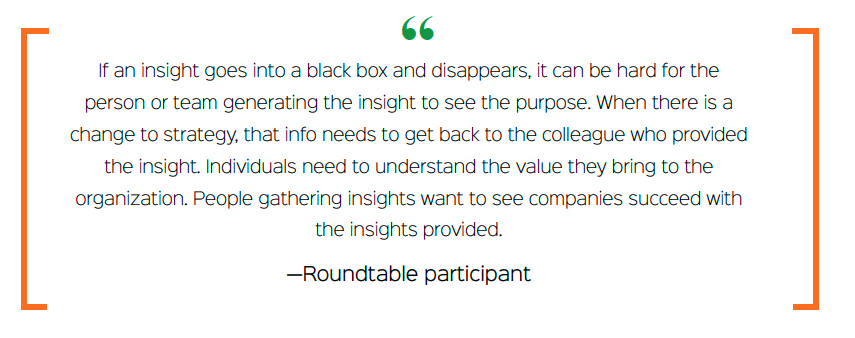
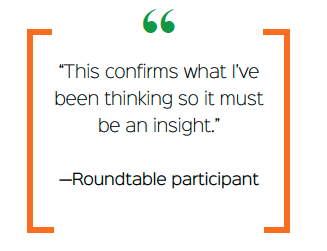 Unfortunately, the internet will provide information to validate any opinion. And because we all want to be proven correct, it’s difficult to avoid subconsciously elevating the insights that confirm our opinions/hypotheses. This is especially challenging when insights conflict with strategy; for example, when the business wants to develop but the insights imply to stop – or when insights are not aligned with Development or Commercial strategy. For this reason, it is important to ensure mechanisms are in place to capture and report surprising insights and not only confirmatory insights, for example by collecting, analyzing and reporting insights beyond only the identified listening priorities.
Unfortunately, the internet will provide information to validate any opinion. And because we all want to be proven correct, it’s difficult to avoid subconsciously elevating the insights that confirm our opinions/hypotheses. This is especially challenging when insights conflict with strategy; for example, when the business wants to develop but the insights imply to stop – or when insights are not aligned with Development or Commercial strategy. For this reason, it is important to ensure mechanisms are in place to capture and report surprising insights and not only confirmatory insights, for example by collecting, analyzing and reporting insights beyond only the identified listening priorities.
Even in large companies, insights are often still shared only in a slide deck or Word document. Worse, insights might be communicated via a quarterly, 20-page email. Communicating relevant insights efficiently and in the right format ensures people continue to read and action the team’s insights communications. That begs the question, What is the right format? In answering this question, Medical Affairs’ scientific, clinical and business acumen are both a blessing and a curse. It can be a curse because scientific training predisposes Medical Affairs professionals to present all the details and methodologies as the narrative leading to conclusions. (Rather than starting with the takeaways and offering details if desired.) But our training also equips us with the skills to digest complicated information and come up with points of relevance. Successful insights teams design the format of insights communication from an audience-centric perspective – speaking the language of business leadership, or Commercial, or even external stakeholders to highlight the “so what” for the person on the receiving end of that sharing.

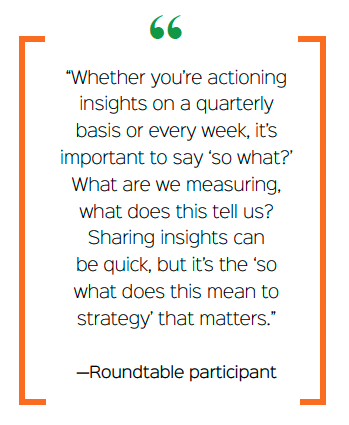
Insights shared yearly run the risk of obsolescence; insights shared in real-time run the risk of initiating an unnecessary “fire drill.” The optimal pacing for insights communication varies based on many factors. What is the pace of change in the disease state? How quickly is the competitive landscape evolving? Most organizations will benefit from a mechanism to flex the pace of insights reporting – but no matter the pace of reporting, the process of creating content based on insights will need to match the pace of insights generation, decreasing the delay between insight and action.
Historically, Medical Affairs has depended on trust in the function to create trust in the insights the function produces: it’s an insight because we are the experts, and we say it’s an insight. This justification has been met with somewhat variable degrees of success. Innovative insights teams are seeking to quantify transparent scientific approaches to insights such that methodology validates legitimacy.
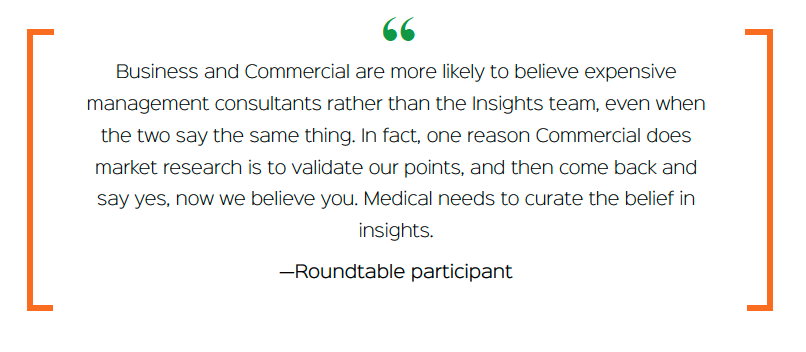
By now, most Medical Affairs organizations recognize the power of insights to transform strategy and actions within the function and more importantly across the business. Most have implemented an insights management process. And, frankly, many are doing it wrong. (Even the authors of this paper who represent cutting edge practices in the field admit to imperfections.) This gap between ideal and actual insights management results in business leaders under-appreciating, deprioritizing and under-resourcing insights activities until Insights teams become stuck in a Catch-22: Resourcing depends on success, and success depends on resourcing. This paper surveys insights leaders to identify specific areas of challenge and specific actions that Insights teams may take to address these challenges. Not all “tips and tricks” will be useful for all organizations (indeed, your organization may already be doing some things right). As such, this paper seeks to demonstrate solidarity with the struggles we all feel in insights management while suggesting a few ways we can address these struggles for the benefit of our individual sanity, team impact, business success – and most importantly, patient benefit.
Writing support provided by Garth Sundem, Director of Communications & Marketing, Medical Affairs Professional Society (MAPS) in accordance with GPP 2022 guidelines.
References:
Reuters and Within3 Medical Affairs survey, May 2023

 How To: Compliance Partnership for Novel Channel Launches
How To: Compliance Partnership for Novel Channel Launches